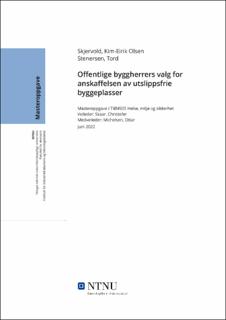| dc.contributor.advisor | Skaar, Christofer | |
| dc.contributor.advisor | Michelsen, Ottar | |
| dc.contributor.author | Skjervold, Kim-Eirik Olsen | |
| dc.contributor.author | Stenersen, Tord | |
| dc.date.accessioned | 2022-10-09T17:19:17Z | |
| dc.date.available | 2022-10-09T17:19:17Z | |
| dc.date.issued | 2022 | |
| dc.identifier | no.ntnu:inspera:115572224:115617610 | |
| dc.identifier.uri | https://hdl.handle.net/11250/3024858 | |
| dc.description.abstract | Gjennom den juridisk bindende Parisavtalen fra 2015 har Norge satt seg mål om å kutte sine nasjonale utslipp med 50-55% av 1990-nivå innen 2030. Dette setter press på bygge- og anleggsbransjen som årlig slipper ut over 2 millioner tonn CO2. For å senke utslippene kreves det en omstilling innad i bransjen, og innføring av ny teknologi som ikke bidrar til direkte utslipp av klimagasser. Manglende nasjonal kravsetting i bygge- og anleggsbransjen har presset offentlige byggherrer til å gå foran og drive utviklingen av utslippsfrie løsninger gjennom kommunale kravsettinger. I et interkommunalt samarbeid fra 2021 signerte flere av Norges største kommuner den ambisiøse Storbyerklæringen som sikter på utslippsfrie byggeplasser- og anleggsplasser innen 2030.
Denne rapporten tar sikte på å skape et kunnskapsgrunnlag for offentlige byggherrers kravsetting av utslippsfrie løsninger i anskaffelsen av framtidige byggeprosjekter. Kunnskapsgrunnlaget baserer seg på en kartlegging av identifiserte utfordringer tilknyttet de mest sentrale utslippsfrie løsningene som benyttes innenfor byggegjerdet. For å understøtte relevansen av utfordringene er det benyttet erfaringer fra Trondheim og Bodø kommune i rollen som offentlige byggherrer, i tillegg til andre relevante aktører innenfor bygge- og anleggsbransjen.
Summen av utfordringene munner i dag ut i en merkostnad for byggherren og entreprenør, og det er forventet at en fortsatt etterspørsel av utslippsfrie løsninger vil senke anskaffelseskostnader og terskelen for å gå til innkjøp av slike løsninger. For at en utvikling skal finne sted, må byggherrer vise betalingsvilje og bidra til innovasjon i anskaffelsesprosessen gjennom å sette realistiske krav som markedet har mulighet til å levere på. De regionale forskjellene rapporten har kartlagt viser at utfordringene tilknyttet utslippsfrie byggeprosjekter gjelder nasjonalt, men størrelsesorden varierer og påvirkes av ulike geografiske faktorer. | |
| dc.description.abstract | Norway has through the legally binding Paris agreement from 2015 set itself ambitious goals of cutting its national greenhouse emissions by 50-55% compared to the 1990 emission levels, within 2030. These national ambitions are pressuring the construction industry in reducing its emissions. In order for this to happen, a restructuring of the industry itself is needed through the introduction of new emission-free technology. The lack of national regulations for the construction industry has pressured the municipalities into spearheading the development of emission-free technology with local regulations, through their role as public developers. In 2021 several of Norway’s largest municipalities signed an ambitious climate agreement that aims to implement emission-free construction sites by 2030.
This study aims to form a compilation of knowledge for public developers’ regulations of emission-free construction sites through the procurement of future building projects. The compilation of knowledge is based on an identification of challenges connected to the most important emission-free technology that is used in the construction zone. To support the inclusion of these challenges, the experiences of the municipalities Trondheim and Bodø in their role as public developers have been mapped. The experiences of other relevant participants in the construction industry have also been mapped.
The sum of these challenges results in an increase of cost for both public developers and contractors, while it is also is to be expected that a higher demand for emission-free technology over time will lower the cost of procurement and the threshold for buying this technology. For such a development to occur, public developers have to show a will to handle these costs and contribute to the development by applying realistic regulations, so that the market has the ability to adapt and deliver. The mapping of the regional differences shows that the challenges connected to emission-free construction sites are universal, but the magnitude of these challenges depends on different geographical factors. | |
| dc.language | nob | |
| dc.publisher | NTNU | |
| dc.title | Offentlige byggherrers valg for anskaffelsen av utslippsfrie byggeplasser | |
| dc.type | Master thesis | |
